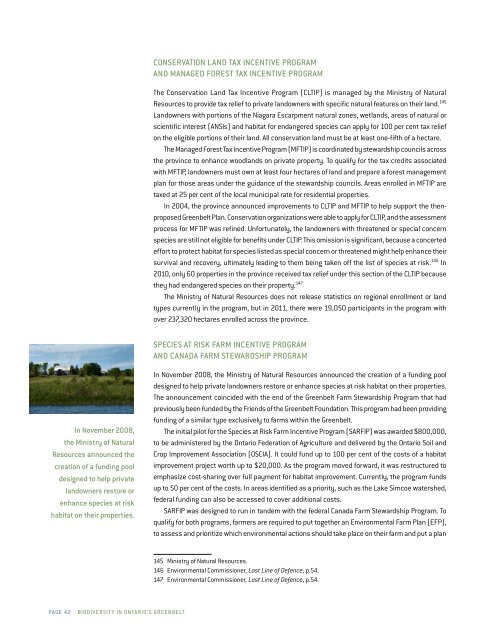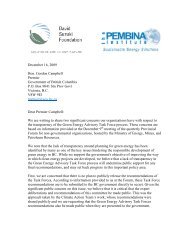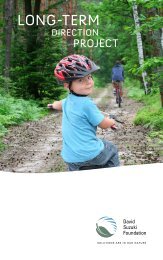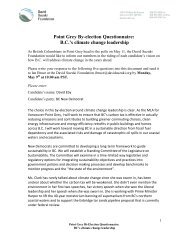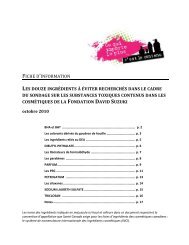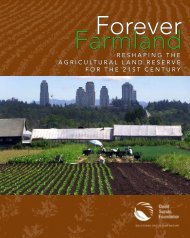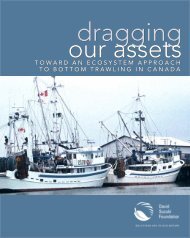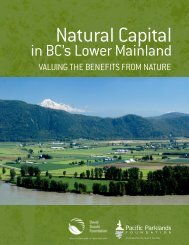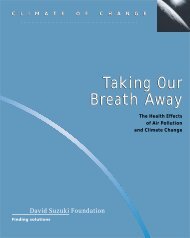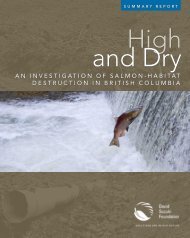Biodiversity in Ontario's Greenbelt (PDF) - David Suzuki Foundation
Biodiversity in Ontario's Greenbelt (PDF) - David Suzuki Foundation
Biodiversity in Ontario's Greenbelt (PDF) - David Suzuki Foundation
You also want an ePaper? Increase the reach of your titles
YUMPU automatically turns print PDFs into web optimized ePapers that Google loves.
Conservation Land Tax Incentive Program<br />
and Managed Forest Tax Incentive Program<br />
The Conservation Land Tax Incentive Program (CLTIP) is managed by the M<strong>in</strong>istry of Natural<br />
Resources to provide tax relief to private landowners with specific natural features on their land. 145<br />
Landowners with portions of the Niagara Escarpment natural zones, wetlands, areas of natural or<br />
scientific <strong>in</strong>terest (ANSIs) and habitat for endangered species can apply for 100 per cent tax relief<br />
on the eligible portions of their land. All conservation land must be at least one-fifth of a hectare.<br />
The Managed Forest Tax Incentive Program (MFTIP) is coord<strong>in</strong>ated by stewardship councils across<br />
the prov<strong>in</strong>ce to enhance woodlands on private property. To qualify for the tax credits associated<br />
with MFTIP, landowners must own at least four hectares of land and prepare a forest management<br />
plan for those areas under the guidance of the stewardship councils. Areas enrolled <strong>in</strong> MFTIP are<br />
taxed at 25 per cent of the local municipal rate for residential properties.<br />
In 2004, the prov<strong>in</strong>ce announced improvements to CLTIP and MFTIP to help support the thenproposed<br />
<strong>Greenbelt</strong> Plan. Conservation organizations were able to apply for CLTIP, and the assessment<br />
process for MFTIP was ref<strong>in</strong>ed. Unfortunately, the landowners with threatened or special concern<br />
species are still not eligible for benefits under CLTIP. This omission is significant, because a concerted<br />
effort to protect habitat for species listed as special concern or threatened might help enhance their<br />
survival and recovery, ultimately lead<strong>in</strong>g to them be<strong>in</strong>g taken off the list of species at risk. 146 In<br />
2010, only 60 properties <strong>in</strong> the prov<strong>in</strong>ce received tax relief under this section of the CLTIP because<br />
they had endangered species on their property. 147<br />
The M<strong>in</strong>istry of Natural Resources does not release statistics on regional enrollment or land<br />
types currently <strong>in</strong> the program, but <strong>in</strong> 2011, there were 19,050 participants <strong>in</strong> the program with<br />
over 237,320 hectares enrolled across the prov<strong>in</strong>ce.<br />
Species at Risk Farm Incentive Program<br />
and Canada Farm Stewardship Program<br />
In November 2008,<br />
the M<strong>in</strong>istry of Natural<br />
Resources announced the<br />
creation of a fund<strong>in</strong>g pool<br />
designed to help private<br />
landowners restore or<br />
enhance species at risk<br />
habitat on their properties.<br />
In November 2008, the M<strong>in</strong>istry of Natural Resources announced the creation of a fund<strong>in</strong>g pool<br />
designed to help private landowners restore or enhance species at risk habitat on their properties.<br />
The announcement co<strong>in</strong>cided with the end of the <strong>Greenbelt</strong> Farm Stewardship Program that had<br />
previously been funded by the Friends of the <strong>Greenbelt</strong> <strong>Foundation</strong>. This program had been provid<strong>in</strong>g<br />
fund<strong>in</strong>g of a similar type exclusively to farms with<strong>in</strong> the <strong>Greenbelt</strong>.<br />
The <strong>in</strong>itial pilot for the Species at Risk Farm Incentive Program (SARFIP) was awarded $800,000,<br />
to be adm<strong>in</strong>istered by the Ontario Federation of Agriculture and delivered by the Ontario Soil and<br />
Crop Improvement Association (OSCIA). It could fund up to 100 per cent of the costs of a habitat<br />
improvement project worth up to $20,000. As the program moved forward, it was restructured to<br />
emphasize cost-shar<strong>in</strong>g over full payment for habitat improvement. Currently, the program funds<br />
up to 50 per cent of the costs. In areas identified as a priority, such as the Lake Simcoe watershed,<br />
federal fund<strong>in</strong>g can also be accessed to cover additional costs.<br />
SARFIP was designed to run <strong>in</strong> tandem with the federal Canada Farm Stewardship Program. To<br />
qualify for both programs, farmers are required to put together an Environmental Farm Plan (EFP),<br />
to assess and prioritize which environmental actions should take place on their farm and put a plan<br />
145 M<strong>in</strong>istry of Natural Resources.<br />
146 Environmental Commissioner, Last L<strong>in</strong>e of Defence, p.54.<br />
147 Environmental Commissioner, Last L<strong>in</strong>e of Defence, p.54.<br />
Page 42<br />
<strong>Biodiversity</strong> <strong>in</strong> Ontario’s greenbelt


